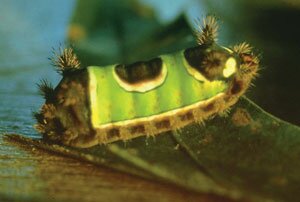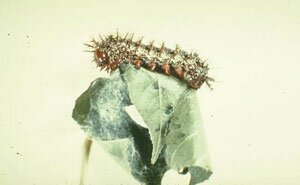GIMME SHELTER- Fuzzy menace: Avoid stinging caterpillars

Peter Warren, Virginia Cooperative Extension, Agriculture & Natural Resources
FILE PHOTO BY DAVE MCNAIR
Q: While I was pruning my shrubbery, I brushed up against an oak tree and something stung me. All I could see was a fuzzy caterpillar. Can a caterpillar sting?
A: The majority of ferocious looking caterpillars are completely harmless. There are, however, six rather common species in Virginia with poisonous hairs or spines. These hairs are hollow and connected to underlying poison glands. Contact with them causes a burning sensation and inflammation that can be as painful as a bee sting. The irritation can last for a day or two and may be accompanied by nausea during the first few hours. Specific symptoms vary depending on the species of caterpillar and the susceptibility of the victim, but usually the site of contact reddens and swells much like a bee sting or the affected area may appear as a small red rash.
A person "stung" by a poisonous caterpillar should immediately wash the affected area to remove any insect hairs and poison that remain. An ice pack will help reduce swelling, and creams and lotions containing steroids will lessen the discomfort and promote healing. People with persistent symptoms lasting after the sting and people known to be sensitive to insect stings should consult a physician.
Most stinging caterpillars are general feeders and are commonly found on shade trees and ornamental shrubs in late summer. The six species common in Virginia are the saddle-back caterpillar, puss caterpillar, hagmoth, hackberry leaf slug, io moth, and buck moth.
The saddle-back caterpillar is about an inch long and has poisonous spines on four large projections (tubercles) and many smaller ones that stick out from the sides of its body. The "saddle" consists of an oval purplish-brown spot in the middle of a green patch on the back. Saddle-back caterpillars feed on the leaves of basswood, chestnut, cherry, plum, oak, and other trees and shrubs.
The puss caterpillar also is about an inch long and completely covered with long, silken brownish hairs. Hidden among the hairs are short, poisonous spines. Puss caterpillars are commonly found on hackberry, elm, plum, sycamore, oak and rose.
Hagmoth larvae are extremely bizarre in appearance. They are covered with short, dark brown hairs and have nine pairs of fleshy appendages, some of which are long and twisted. Rose, sassafras, alder, and spirea are among their favorite hosts.
The Hackberry leaf slug grows to about an inch long and has six small tufts of hair on each segment. Its body is off-white with a large purple patch on the back. Hackberry leaves are its preferred food.
A mature io moth caterpillar may be up to 2 1/2 inches long. They are a beautiful pale green color with white and red stripes on the sides. Short spines radiate from numerous tubercles on the back. These larvae feed on alder, ash, birch, cherry, elm, locust, oak, sassafras, and other deciduous trees and herbaceous plants. They are not uncommon in corn fields.
The buck moth caterpillar is unusual in this group since it's found in the early summer, principally in June. It's often confused with spiny elm caterpillars and gypsy moth caterpillars which also are active at that time. Buck moth caterpillars grow up to two inches long. Their heads, prolegs, and anal plate are reddish, but the rest of the body is black with small white spots. Long-branched spines and tufts of shorter spines cover the body. Buck moth caterpillars are found most commonly on oak, but willow, hazelnut, cherry, and rose also are suitable host plants.
Stinging caterpillars rarely occur in sufficient numbers to be considered plant pests, but people who work with ornamental plants should learn to recognize them and avoid touching them. If you're not sure, avoid the fuzzy ones.

Saddle-back caterpillar
WEB PHOTO

io moth caterpillar
WEB PHOTO

Buck moth caterpillar
WEB PHOTO
#
2 comments
My son loves bugs and today he found a white fussy caterpillar. Shortly after he picked it up he was in pain and very very itchy. I have never heard of caterpillar doing that. Now he has a rash and just maybe he might leave the bugs alone.
My 2 kids were playing outside today before lunch. They found 2 white, very hairy caterpillars with black spots down the midline of the back under a black cherry tree. A short time after picking them up my 3 year old son was screaming in pain! My daughter also complained of itching and burning on her hands. The pediatrician's office suggested soaking their hands in a sink of cold water and administering benedryl. A few hours later, by dinner time, they were covered in a red bumpy rash on their torsos, arms, legs, hands.
None of the photos of caterpillars I have seen online tonight look like the ones that stung them. Any suggestions as to what they might be?